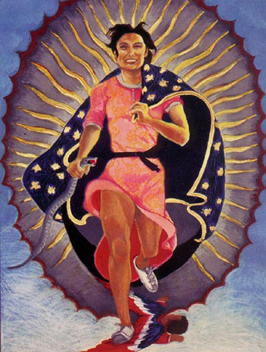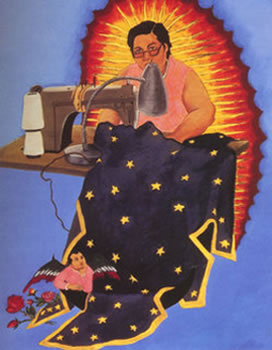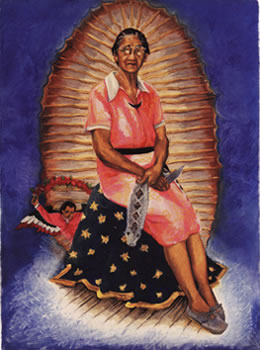| HOME | BIOGRAPHY | TIMELINE | ART | BIBLIOGRAPHY | LINKS | LETTER |
|---|
The Guadalupe Series
Yolanda Lopez, Portrait of the Artist as the Virgen of Guadalupe,1978.Downloaded from www.dartmouth.edu.
Yolanda Lopez, Margaret F. Stewart:Our Lady of Guadalupe,1978.Downloaded from www.csupomona.edu.
Yolanda Lopez, Guadalupe:Victoria F. Franco,1978.Scanned from Yolanda Lopez by Karen M. Davalos.
Yolanda Lopez has received the majority of her fame through the creation of her Guadalupe series. This groundbreaking series has transformed the way in which the iconic image of the Virgin of Guadalupe is viewed into a much more personal and political ideal. Lopez claims that in creating the Portrait of the Artist as the Virgin of Guadalupe she questioned this common icon of the ideal woman in the Chicano culture. The goal of Lopez was to demonstrate and consider the new types of role models Chicanas need and not simply adopt anything just because it is Mexican. Yolanda stated that by doing these portraits of her mother, grandmother, and herself she wanted to draw attention and pay homage to working class women, old women, middle-aged over weight women, young, and self assertive women. By naming each drawing individually Lopez emphasizes the uniqueness of each woman and accentuates the society that allows women of color to go unnoticed.
In the Portrait of the Artist as the Virgin of Guadalupe, Yolanda illustrates the strength and the power by the muscular legs and the long strides as well as the leap she has taking from the crescent moon. Through this long leap Lopez demonstrates that Chicanas are free from the oppressive social stigmas that limit women’s form of expression. In Margaret F. Stewart: Our Lady of Guadalupe, Lopez depicts her mother at work but proposes a new type of beauty. This new beauty is not the typical beauty that is depicted by others as the slender body type, white, young, and glamorous but as the older an fuller woman hard at work. Lastly in Guadalupe: Victoria F. Franco, Lopez illustrates her grandmother as a sad but strong old woman. In each portrait Lopez incorporates a serpent but the serpent in her grandmother’s portrait has been skinned and the grandmother holds the serpent skin in her left hand and the knife that was used in on her right hand. Lopez states “ She is holding the knife herself, because she’s no longer struggling with life and sexuality. She has her own power.” According to Dr. Davalos (author of Yolanda Lopez) the first two portraits represent lived realities of Chicana women and the last portrait address death.


